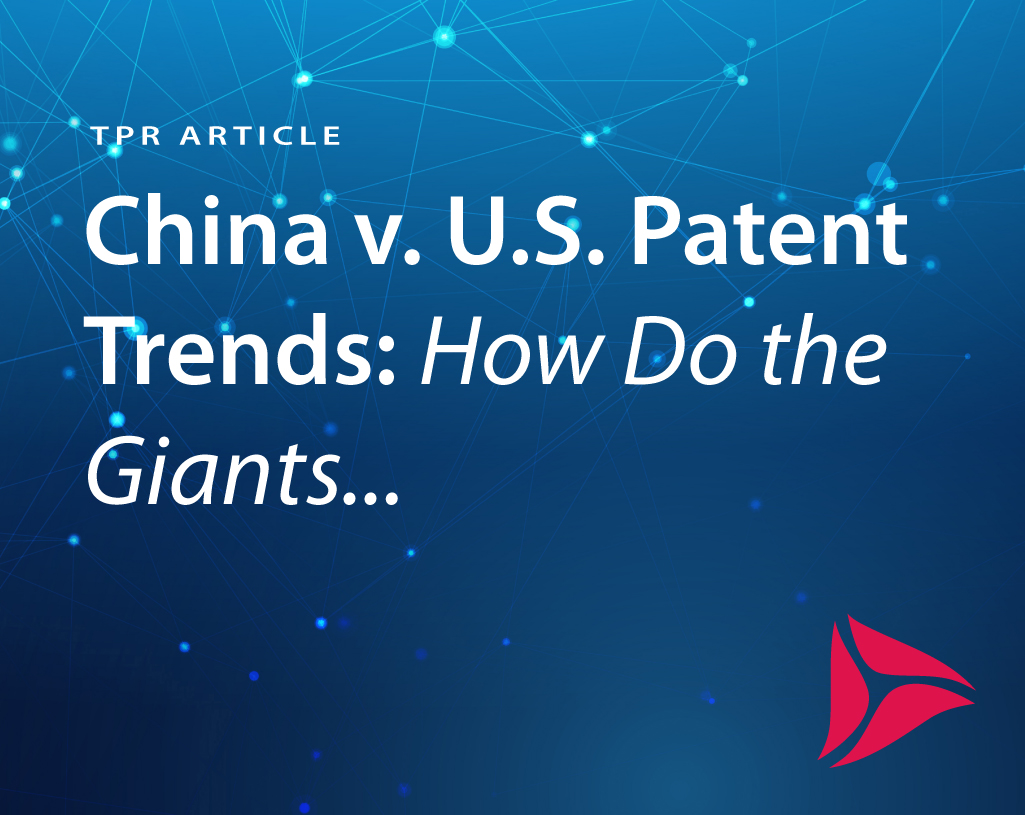The Chinese State Intellectual Property Office, SIPO, became the first office to receive over one million invention patent applications in a single year. Read on to see how statistical patent trends compare between China and the U.S. and some of the reasons why we are seeing explosive growth in China in recent years….
On January 14, 2016, China’s State Intellectual Property Office held a news conference in Beijing and released data that put China once again in the patent spotlight: The number of invention patent applications received by China in 2015 broke the 1 million barrier, reaching 1.102 million and showing an increase of 18.7% over the previous year. This contrasts with the United States, where figures released by the USPTO for 2015 show an increase of 1.8% in utility patents from 578,802 in 2014 to 589,410 in 2015. What is more, 359,000 invention patents were authorized in China in 2015, with 263,000 being granted to domestic applicants, up 100,000 over 2014.
The article below takes a look at patenting trends in recent years to see how China and the U.S. have compared in terms of the number of patent applications. Utility invention patent statistics are reviewed over the 10-year period from 2004 thru 2014, drawing from the latest ‘World Intellectual Property Indicators’ report that that was released by WIPO in December 2015, as well as other resources.
Demographics – China and the US
Fig 1. shows the backdrop for the comparison by showing some of the demographics of China compared to the U.S. for 2014. It’s no surprise that China had the highest world population, and the U.S. came in third. The GDP’s for China and the U.S. were still somewhat apart when measured in Billions of U.S. Dollars – the U.S. ranking #1, with 17 Trillion, and China ranking #2 with 10 Trillion. However, when measured with respect to Purchasing Power Parity (shown here as the cost in U.S. Dollars for purchasing specific goods and services in each country), then the GDP gap changed and China pulled slightly ahead. We also saw that China and the U.S. were vying for first place in R&D expenditure.
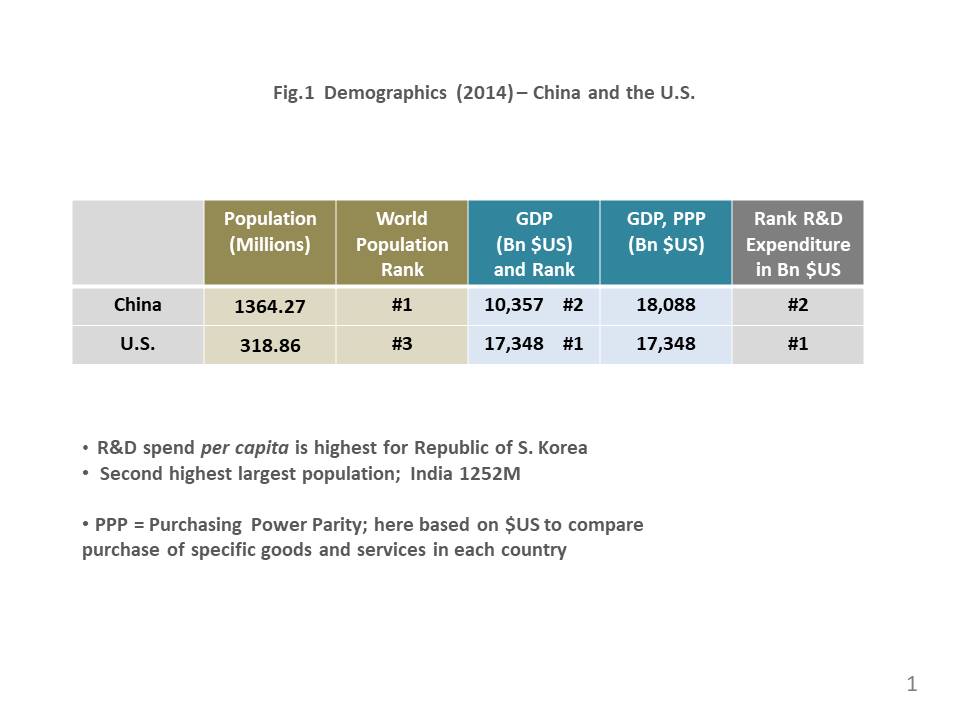
Patent Applications– US Patent Office
Fig 2 shows that in 2014 there was a close balance between applications made to the USPTO by residents and non-residents, each reaching almost 300,000 applications. ‘Abroad’ filings are not too far behind. In fact, as a country, the U.S. (along with Japan) accounted for the most patents filed in the ‘abroad’ category.
Around the centre of the graph it is possible to see a little slowing of the upward trend that was happening before 2008, but overall very positive growth is seen through 2014.
(Note: The statistical category definitions per WIPO are as follows: A ‘resident’ filing refers to an application filed in the country by its own resident; whereas a ‘non-resident’ filing refers to the one filed by a foreign applicant. An ‘abroad’ filing refers to an application filed by this country’s resident at a foreign office).
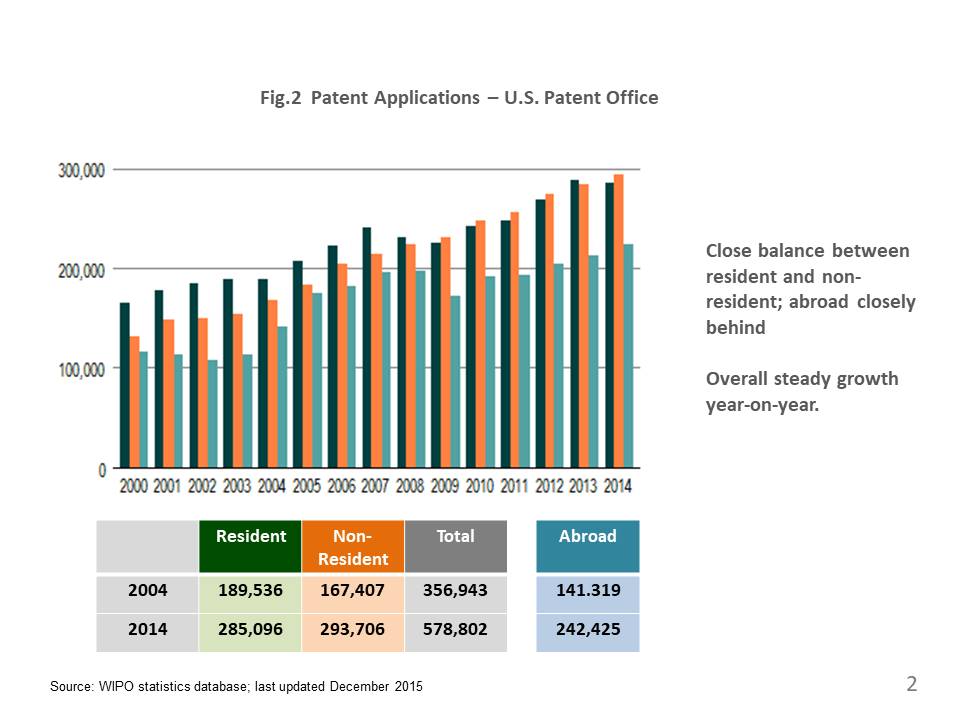
Patent Applications– Chinese Patent Office
Fig.3 shows applications made to the Chinese Patent Office over the same time period. The first thing to note is that the y-axis here reaches to 800,000, whereas in Fig.2 the y-axis for applications in the U.S. stops below 300,000.
In China in 2004, there were roughly equal resident to non-resident applications. Fast-forward to 2014, and we see a dramatic growth in patent applications from residents – a more than 12-fold increase over 2004. By comparison, non-resident filings doubled.
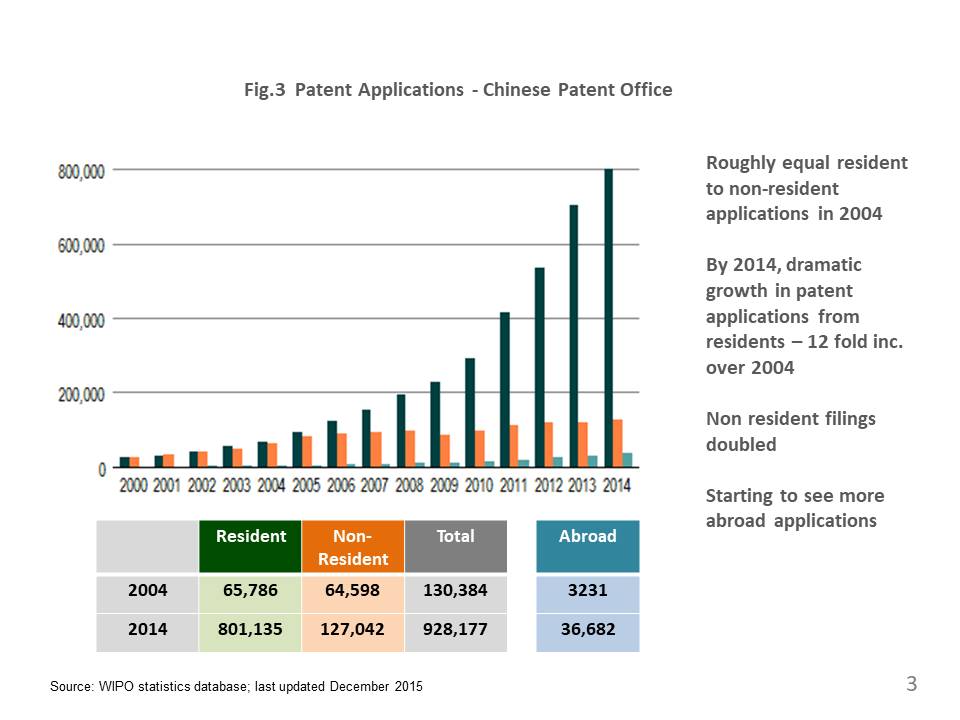
What Figs 2 and 3 show, by comparing the totals in the grey boxes, is that in 2004 there were nearly 3 times as many applications in the U.S. in total compared to applications in China, whereas by 2014, China had overtaken the U.S. on the total number of applications received, with China exceeding the U.S. by a factor of 1.6 : 1
With the latest statistics released in January 2016, we see that China handled more patent applications for inventions than any other country for the fifth year running in 2015.
Patents in Force – China and the US
Fig.4 compares the number of patents in force in the U.S. and China respectively. China has over 1M patents in force, and this number is expected to continue to rise rapidly as the new, higher number of applications work their way through the system. The number of in-force patents in the U.S. rose to just over 2 times that of China, compared with 9 times that of China 10 years previously.
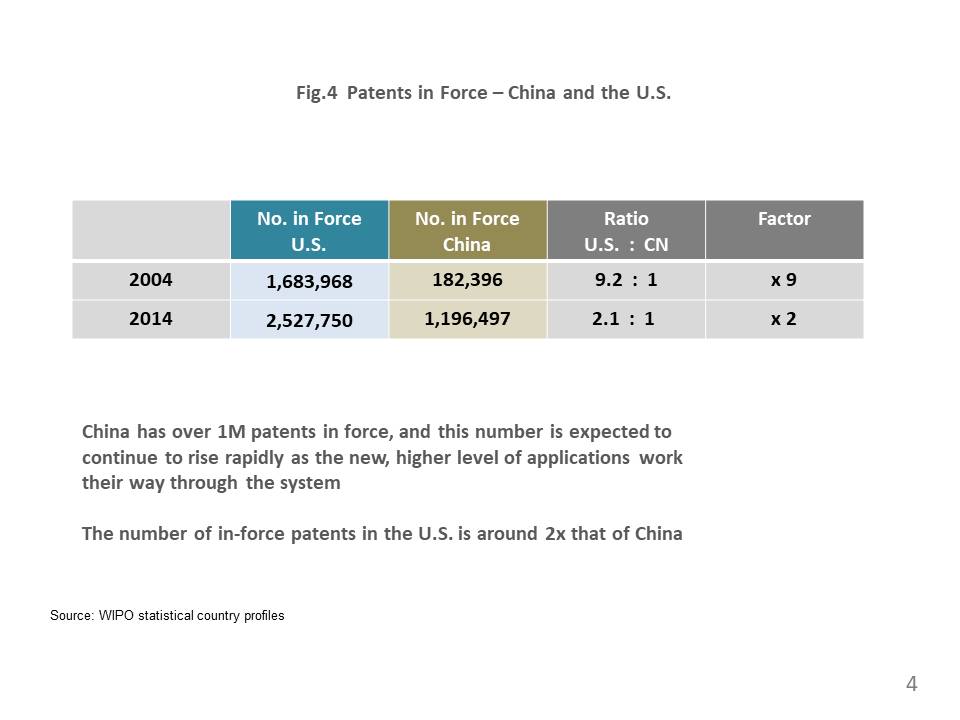
Patent Applications at the Top 10 Offices
Going back to applications, Fig.5 shows the Top 10 offices in 2014, which feature all of the BRIC countries, along with Japan, Korea, the EPO, Germany and Canada. Global patent filings rose in 2014 for the 5th year running, with China being the main contributor. Of the 2.68M applications worldwide in 2014, China led with 928,177, followed by the U.S., with 578,802 and then Japan with 325,989. That’s 1.8M just from the top 3 alone. China led the pack, showing a double-digit growth of 12.5% over the previous year and, in 2014 accounting for more than the next 2 jurisdictions combined, i.e. from the U.S. and Japan put together.
Another important statistic to note is that, in 2014, 60% of worldwide patent applications were made in Asia, notably in China, Japan and the Republic of Korea. That is up from 49% in 2004.
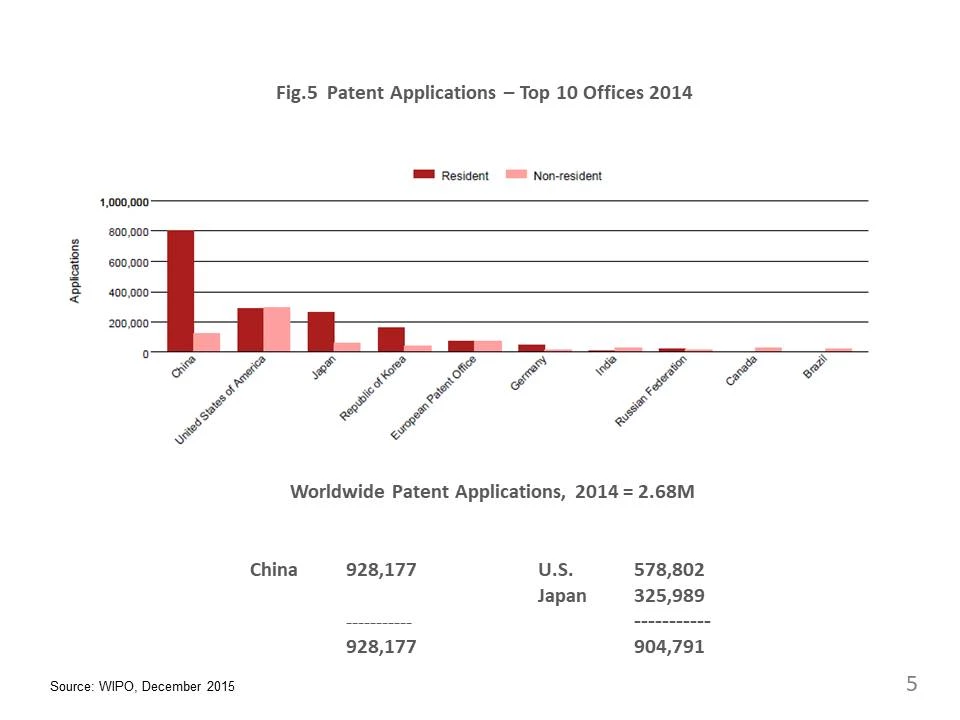
Significance of Increase in China’s Patenting Activity
So what could be some of the reasons for the high numbers of patents filed or granted in China?
One factor, of course, is that economic growth in China has led to the need to “buy-in” to the global IP system, as well as the desire to reinforce the “Made in China / Created in China” philosophy. In October, policy makers named innovation as one of the five key concepts for the development of China for 2016 thru 2020. Tax breaks and other significant incentives have already been introduced to support patent filings by Chinese entities, as well as rewards for patent grants. Of course, other nations also have incentive plans in place, such as reduced filing fees in the U.S., Korea and Singapore, so that is not unique.
While it does appear that the Chinese patent office approves a greater proportion of overall applications compared to international counterparts, it is uncertain what this may indicate with regard to patent quality. It is true that we do not have metrics to compare patent quality in different jurisdictions, and we can’t exactly measure how rigorous the examination process is in any country. However, it is a natural progression for quality to continue to increase over time, and inevitable that the sheer numbers going through the system mean that Chinese patents will play an increasingly major role towards significant advances in global innovation as well as representing a growing body of significant prior art.
Until now, there appears to have been a two-tiered system of patent awareness in China. The top level has comprised a core group of 100+ entities that have already integrated patents as part of their modus operandi, while a second tier of organizations is rapidly emerging that is becoming increasingly patent savvy. While the second tier appears currently to be motivated by incentives, how long is it likely to be before such companies turn their attention towards reaping the even greater benefits of investing in a highly-directed global patent strategy? A substantial rise in filing abroad, for example, is an obvious advance for a country that has a large, educated and motivated workforce where investment in R&D, as was noted earlier, is the world’s number two. As an example, the share of Chinese applicants at the USPTO accounted for 3% in 2010, but 6% in 2014. What can be expected in 2024?
Another factor driving applications is that global enterprises (in addition to domestic ones) are increasingly seeking protection in China to mitigate future infringement risk, and to secure China as a consumer-rich market for the manufacture and sale of core technologies.
Considerations When Searching Chinese Patents
Despite the obvious language barrier, Chinese patents should be searched carefully, as they are going to increasingly feature as critical prior art in patentability and validity cases, as well as in freedom-to-operate evaluations and licensing, etc.
Also, it is worth considering in what situations a search may need to be performed in China by a native language searcher, rather than searching via English abstracts or machine translations. As a professional search firm with specialized international reach, TPR is seeing an increasing demand for native language searching not only in China, but also in other Asian countries. Many clients rely on TPR for conducting such native-language searches on-the-ground in these countries when needed. Even stretching beyond patents, scientific and technical publications in Chinese language have also become very prolific. This, after all, is just another aspect of the same story.
Selected Sources
GDP World Rankings; Knoema
http://knoema.com/nwnfkne/world-gdp-ranking-2015-data-and-charts
World Intellectual Property Organization (WIPO) Statistical Country Profiles
http://www.wipo.int/ipstats/en/statistics/country_profile/
WIPO World Intellectual Property Indicators – 2015 Edition
http://www.wipo.int/ipstats/en/wipi/
WIPO Press Release, December 14, 2015 on Global Patent Filings
http://www.wipo.int/pressroom/en/articles/2015/article_0016.html
USPTO Patent Statistics Chart, 1963-2015
http://www.uspto.gov/web/offices/ac/ido/oeip/taf/us_stat.htm
IAM Blog – January 21, 2016; Latest filing statistics show the growing value being attached to Chinese patents by foreign entities [link no longer available]
China’s State IP Office (SIPO), January 15, 2016; Patent filings and grant statistics for 2015 (Chinese language webpage)
http://mp.weixin.qq.com/s?__biz=MjM5NTUxNjk2MA==&mid=401765161&idx=1&sn=2bdf978de01650fe25bad2963f95619f#rd
http://english.sipo.gov.cn/statistics/index_3.html
State Council for PRC — January 14, 2016; China Continues to Top patent Application List
http://english.gov.cn/state_council/ministries/2016/01/14/content_281475271944980.htm
Article contributed by:
Trudi Jones, Vice President of Technology & Patent Research International, Inc.
Trudi Jones studied Chemistry at Kings College, London University, and started her professional career with Thomson (now Thomson Reuters) by developing databases for providing patent, scientific and technical information to research-based organizations. In the early 90’s, Trudi co-founded Technology & Patent Research to fulfill the unmet need for a high-level search firm that could support Information Professionals and Patent Attorneys by providing searching and analysis services in support of their work. TPR has been successfully providing support to corporations and law firms across all technologies ever since and continues to set the standard for professional search services.
© 2016, Technology & Patent Research International, Inc.
